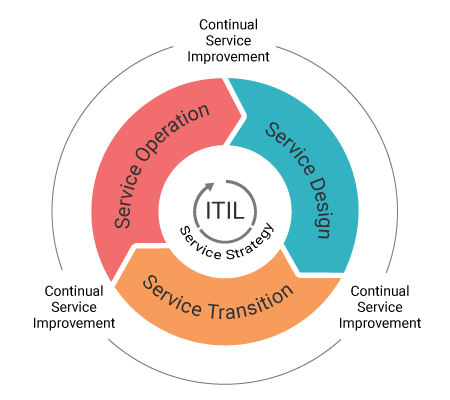
The ITIL framework encompasses the complete information technology lifespan in a company. It is termed the IT Service Lifecycle. Service lifecycle is an approach to ITSM Certification Courses that places an emphasis on how important coordination and control is, across the various functions, processes, and systems that are necessary to manage the complete lifecycle of IT services. The approach of service lifecycle takes into consideration the strategy, design, transition, operation, and continual improvement of IT services. It is also known as the service management lifecycle.
ITIL Service Life Cycle
The elements in the ITIL Service Lifecycle are covered in a set of 5 publications. Each of the following publications covers a particular stage of the service lifecycle.
-
ITIL Service Strategy (SS) – Initial definition
-
ITIL Service Design (SD) – Analysis of business requirements
-
ITIL Service Transition (ST) – Migration into the live environment
-
ITIL Service Operation (SO) – Live operation
-
ITIL Continuous Service Improvement (CSI) – Improvement
The following illustration shows the ITIL Service Lifecycle:
Benefits of ITIL Framework
The ITIL framework is a source of best practice in service management because of the following reasons:
-
IT is vendor-neutral
-
ITIL Framework Non-prescriptive
-
It is a best practice
The Success of ITIL Framework
The reason for ITIL’s success is that it describes the practices which allow organizations to provide benefits, return on investment, and sustained success, which has enabled organizations to do the following:
-
Integrate the service strategy with the existing business strategy and the needs of the customer.
-
Deliver value for customers through the services, thus improving their relationship with the customers.
-
Enable a standard approach to service management is adopted across the entire organization.
-
To deliver services efficiently and effectively by managing the IT investment and budget, risks, knowledge, capabilities, and resources.
-
Measure, monitor, and optimize the performance of the IT service and service provider while reducing costs.
-
To change the culture of the organization to allow sustained success to be achieved.

ITIL Guidance
The ITIL guidance can be adapted in such a way so as to support multiple business environments and organizational strategies. ITIL guidance can be found in the following:
-
The ITIL Core: They are best practice publications that are applicable to all the different types of organizations that provide services to a business.
-
ITIL complementary guidance: It is a complementary set of publications with guidance that is specific to industry sectors, organization types, operating models, and technology architectures.
Conclusion
The Information technology Infrastructure Library has been deployed successfully in organizations all over the world for over 20 years. Over these years, the framework has evolved from a specialized set of service management topics with a focus on function to a process-based framework that now provides a broader holistic service lifecycle. Learn more about the ITIL framework with ITIL 4 Foundation training, and gain enriching skills and best practices in service management.
Know more about Service Management best practices through Invensis Learning’s IT Service Management certification training on ITIL 4 Certification, SIAM Foundation, SIAM professional, VeriSM, etc.
















